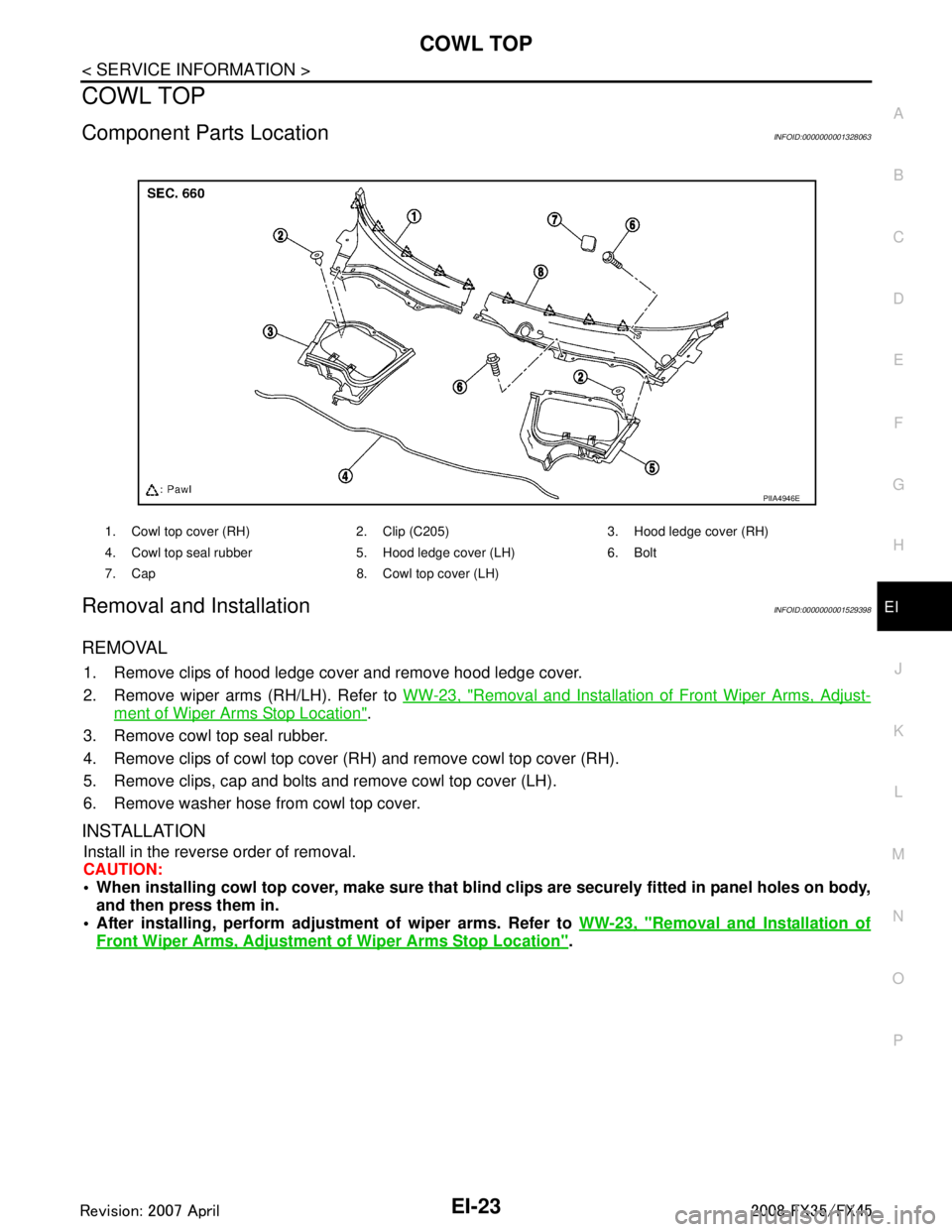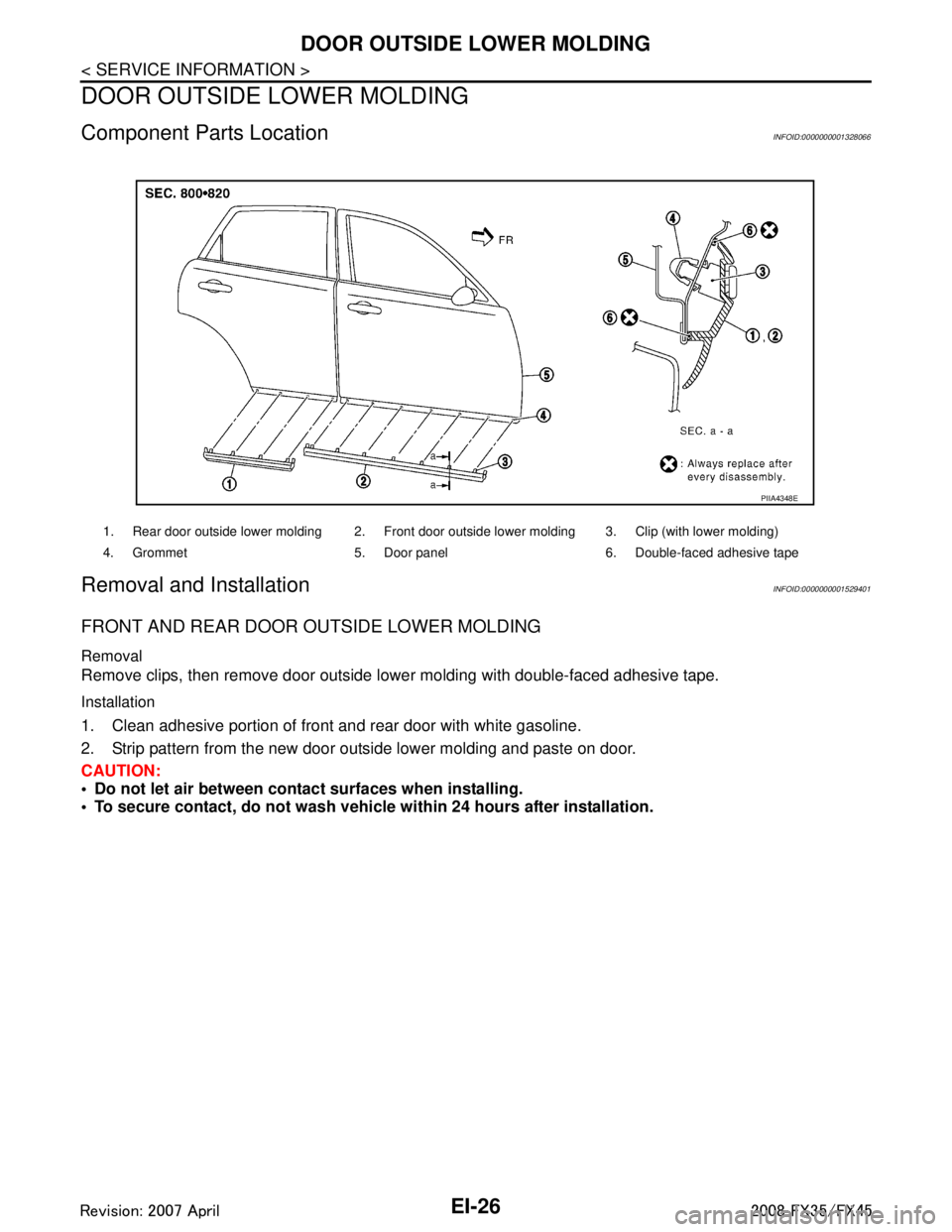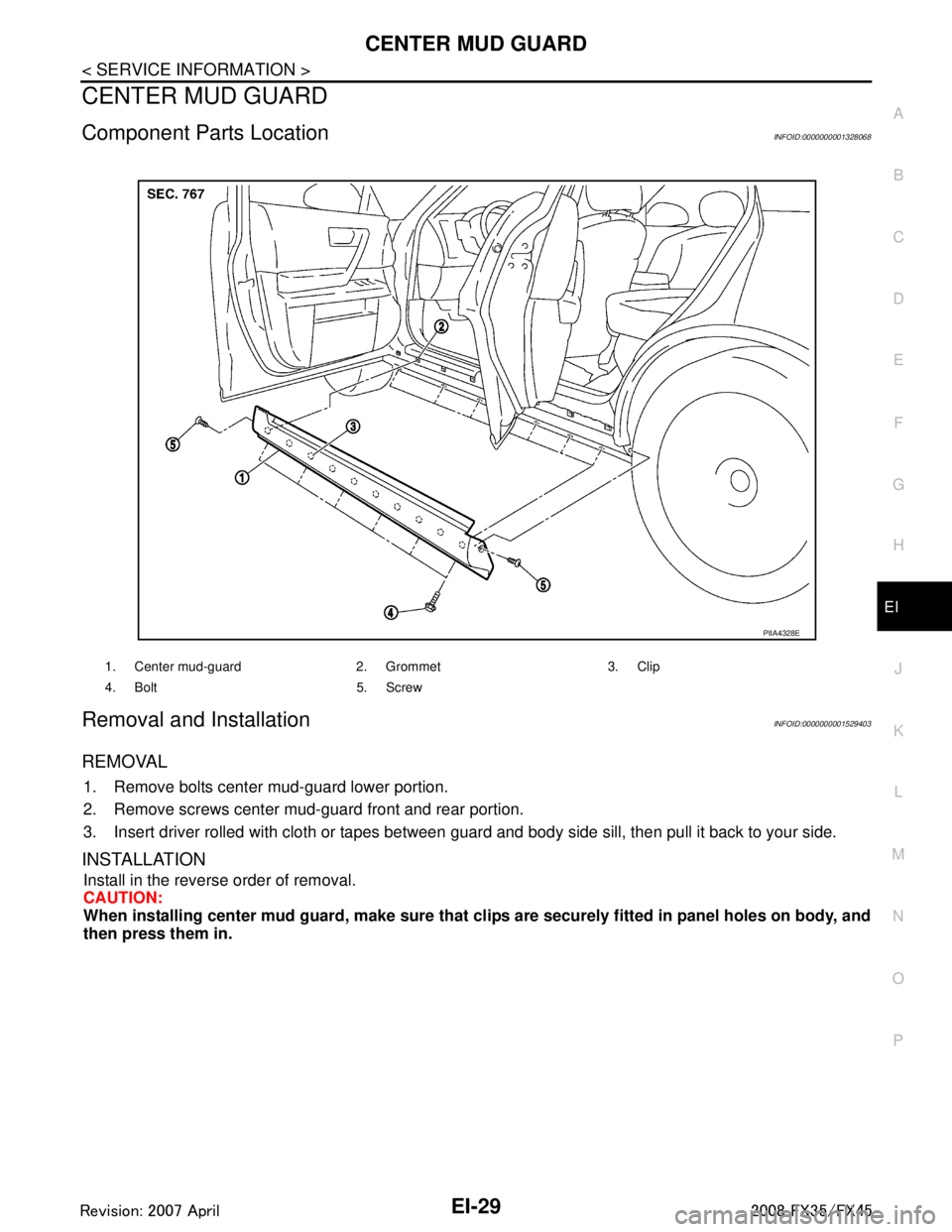2008 INFINITI FX35 ECU
[x] Cancel search: ECUPage 2254 of 3924
![INFINITI FX35 2008 Service Manual
EC-1014
< SERVICE INFORMATION >[VK45DE]
DTC P0850 PNP SWITCH
DTC P0850 PNP SWITCH
Component DescriptionINFOID:0000000001326872
When the selector lever position is P or N,
park/neutral position (PNP) INFINITI FX35 2008 Service Manual
EC-1014
< SERVICE INFORMATION >[VK45DE]
DTC P0850 PNP SWITCH
DTC P0850 PNP SWITCH
Component DescriptionINFOID:0000000001326872
When the selector lever position is P or N,
park/neutral position (PNP)](/manual-img/42/57017/w960_57017-2253.png)
EC-1014
< SERVICE INFORMATION >[VK45DE]
DTC P0850 PNP SWITCH
DTC P0850 PNP SWITCH
Component DescriptionINFOID:0000000001326872
When the selector lever position is P or N,
park/neutral position (PNP) switch is ON.
ECM detects the position because the conti nuity of the line (the ON signal) exists.
CONSULT-III Reference Value in Data Monitor ModeINFOID:0000000001326873
Specification data are reference values.
On Board Diagnosis LogicINFOID:0000000001326874
DTC Confirmation ProcedureINFOID:0000000001326875
CAUTION:
Always drive vehicle at a safe speed.
NOTE:
If DTC Confirmation Procedure has been previously conduc ted, always turn ignition switch OFF and wait at
least 10 seconds before conducting the next test.
WITH CONSULT-III
1. Turn ignition switch ON.
2. Select “P/N POSI SW” in “DATA MONITOR” mode wit h CONSULT-III. Then check the “P/N POSI SW” sig-
nal under the following conditions.
If NG, go to EC-1017, "
Diagnosis Procedure".
If OK, go to following step.
3. Start engine and warm it up to normal operating temperature.
4. Maintain the following conditions for at least 60 consecutive seconds.
5. Check 1st trip DTC.
6. If 1st trip DTC is detected, go to EC-1017, "
Diagnosis Procedure".
MONITOR ITEM CONDITION SPECIFICATION
P/N POSI SW Ignition switch: ON Selector lever: P or N ON
Selector lever: Except above OFF
DTC No. Trouble diagnosis name DTC detecting condition Possible cause
P0850
0850 Park/neutral position
switch The signal of the park/neutral position (PNP)
switch is not changed in the process of engine
starting and driving. Harness or connectors
[The park/neutral position (PNP) switch
circuit is open or shorted.]
Park/neutral position (PNP) switch
Unified meter and A/C amp.
TCM
Position (Selector lever) Known-good signal
N or P position ON
Except above position OFF
ENG SPEED 1,200 - 6,375 rpm
COOLAN TEMP/S More than 70 °C (158 °F)
B/FUEL SCHDL 2.0 - 31.8 msec
VHCL SPEED SE More than 64 km/h (40 MPH)
Selector lever Suitable position
3AA93ABC3ACD3AC03ACA3AC03AC63AC53A913A773A893A873A873A8E3A773A983AC73AC93AC03AC3
3A893A873A873A8F3A773A9D3AAF3A8A3A8C3A863A9D3AAF3A8B3A8C
Page 2300 of 3924
![INFINITI FX35 2008 Service Manual
EC-1060
< SERVICE INFORMATION >[VK45DE]
DTC P1572 ICC BRAKE SWITCH
DTC P1572 ICC BRAKE SWITCH
Component DescriptionINFOID:0000000001326935
When the brake pedal is depressed,
ICC brake switch is turn INFINITI FX35 2008 Service Manual
EC-1060
< SERVICE INFORMATION >[VK45DE]
DTC P1572 ICC BRAKE SWITCH
DTC P1572 ICC BRAKE SWITCH
Component DescriptionINFOID:0000000001326935
When the brake pedal is depressed,
ICC brake switch is turn](/manual-img/42/57017/w960_57017-2299.png)
EC-1060
< SERVICE INFORMATION >[VK45DE]
DTC P1572 ICC BRAKE SWITCH
DTC P1572 ICC BRAKE SWITCH
Component DescriptionINFOID:0000000001326935
When the brake pedal is depressed,
ICC brake switch is turned OFF
and stop lamp switch is turned ON. ECM detects the state of the
brake pedal by this input of two kinds (ON/OFF signal).
Refer to ACS-7
for the ICC function.
CONSULT-III Reference Value in Data Monitor ModeINFOID:0000000001326936
Specification data are reference values.
On Board Diagn osis LogicINFOID:0000000001326937
This diagnosis has the one trip detection logic.
The MIL will not light up for this diagnosis.
NOTE:
If DTC P1572 is displayed with DTC P0605, first pe rform the trouble diagnosis for DTC P0605. Refer
to EC-1007
.
This self-diagnosis has the one tr ip detection logic. When malfunction A is detected, DTC is not
stored in ECM memory. And in that case, 1st trip DTC and 1st trip freeze frame data are displayed.
1st trip DTC is erased when igniti on switch OFF. And even when ma lfunction A is detected in two
consecutive trips, DTC is not stored in ECM memory.
DTC Confirmation ProcedureINFOID:0000000001326938
CAUTION:
Always drive vehicle at a safe speed.
NOTE:
If DTC Confirmation Procedure has been previously conduc ted, always turn ignition switch OFF and wait at
least 10 seconds before conducting the next test.
PBIB2558E
MONITOR ITEM CONDITION SPECIFICATION
BRAKE SW1
(ICC brake switch) Ignition switch: ON Brake pedal: Fully released ON
Brake pedal: Slightly depressed OFF
BRAKE SW2
(Stop lamp switch) Ignition switch: ON Brake pedal: Fully released OFF
Brake pedal: Slightly depressed ON
DTC No.
Trouble diagnosis
name DTC detecting condition Possible cause
P1572
1572 ICC brake switch A)
When the vehicle speed is above 30 km/h
(19 MPH), ON signals from the stop lamp
switch and the ICC brake switch are sent to
ECM at the same time. Harness or connectors
(The stop lamp switch circuit is shorted.)
Harness or connectors (The ICC brake switch circuit is shorted.)
Stop lamp switch
ICC brake switch
ICC brake hold relay
Incorrect stop lamp switch installation
Incorrect ICC brake switch installation
ECM
B)
ICC brake switch signal is not sent to ECM
for extremely long time while the vehicle is
driving
3AA93ABC3ACD3AC03ACA3AC03AC63AC53A913A773A893A873A873A8E3A773A983AC73AC93AC03AC3
3A893A873A873A8F3A773A9D3AAF3A8A3A8C3A863A9D3AAF3A8B3A8C
Page 2308 of 3924
![INFINITI FX35 2008 Service Manual
EC-1068
< SERVICE INFORMATION >[VK45DE]
DTC P1572 ASCD BRAKE SWITCH
DTC P1572 ASCD BRAKE SWITCH
Component DescriptionINFOID:0000000001326942
When the brake pedal is depressed, ASCD brake switch is tu INFINITI FX35 2008 Service Manual
EC-1068
< SERVICE INFORMATION >[VK45DE]
DTC P1572 ASCD BRAKE SWITCH
DTC P1572 ASCD BRAKE SWITCH
Component DescriptionINFOID:0000000001326942
When the brake pedal is depressed, ASCD brake switch is tu](/manual-img/42/57017/w960_57017-2307.png)
EC-1068
< SERVICE INFORMATION >[VK45DE]
DTC P1572 ASCD BRAKE SWITCH
DTC P1572 ASCD BRAKE SWITCH
Component DescriptionINFOID:0000000001326942
When the brake pedal is depressed, ASCD brake switch is turned
OFF and stop lamp switch is turned ON. ECM detects the state of
the brake pedal by this input of two kinds (ON/OFF signal).
Refer to
EC-615
for the ASCD function.
CONSULT-III Reference Value in Data Monitor ModeINFOID:0000000001326943
Specification data are reference values.
On Board Diagn osis LogicINFOID:0000000001326944
This self-diagnosis has the one trip detection logic.
The MIL will not light up for this diagnosis.
NOTE:
If DTC P1572 is displayed with DTC P0605, first pe rform the trouble diagnosis for DTC P0605. Refer
to EC-1007
.
This self-diagnosis has the one tr ip detection logic. When malfunction A is detected, DTC is not
stored in ECM memory. And in that case, 1st trip DTC and 1st trip freeze frame data are displayed.
1st trip DTC is erased when igniti on switch OFF. And even when ma lfunction A is detected in two
consecutive trips, DTC is not stored in ECM memory.
DTC Confirmation ProcedureINFOID:0000000001326945
CAUTION:
Always drive vehicle at a safe speed.
NOTE:
If DTC Confirmation Procedure has been previously conduc ted, always turn ignition switch OFF and wait at
least 10 seconds before conducting the next test.
Procedure for malfunction B is not described here. It takes extremely long time to complete procedure for
malfunction B. By performing procedur e for malfunction A, the incident that causes malfunction B can be
detected.
PBIB2558E
MONITOR ITEM CONDITION SPECIFICATION
BRAKE SW1
(ASCD brake switch) Ignition switch: ON Brake pedal: Fully released ON
Brake pedal: Slightly depressed OFF
BRAKE SW2
(Stop lamp switch) Ignition switch: ON Brake pedal: Fully released OFF
Brake pedal: Slightly depressed ON
DTC No.
Trouble diagnosis
name DTC detecting condition Possible cause
P1572
1572 ASCD brake switch A)
When the vehicle speed is above 30 km/h
(19 MPH), ON signals from the stop lamp
switch and the ASCD brake switch are sent
to the ECM at the same time. Harness or connectors
(The stop lamp switch circuit is shorted.)
Harness or connectors (The ASCD brake switch circuit is shorted.)
Stop lamp switch
ASCD brake switch
Incorrect stop lamp switch installation
Incorrect ASCD brake switch installation
ECM
B)
ASCD brake switch signal is not sent to
ECM for extremely long time while the ve-
hicle is driving.
3AA93ABC3ACD3AC03ACA3AC03AC63AC53A913A773A893A873A873A8E3A773A983AC73AC93AC03AC3
3A893A873A873A8F3A773A9D3AAF3A8A3A8C3A863A9D3AAF3A8B3A8C
Page 2443 of 3924

EI-6
< SERVICE INFORMATION >
SQUEAK AND RATTLE TROUBLE DIAGNOSES
If the noise can be duplicated easily during the test drive, to help identify the source of the noise, try to dupli-
cate the noise with the vehicle stopped by doing one or all of the following:
1) Close a door.
2) Tap or push/pull around the area where the noise appears to be coming from.
3) Rev the engine.
4) Use a floor jack to recreate vehicle “twist”.
5) At idle, apply engine load (electrical load, half- clutch on M/T model, drive position on A/T model).
6) Raise the vehicle on a hoist and hit a tire with a rubber hammer.
Drive the vehicle and attempt to duplicate the conditions the customer states exist when the noise occurs.
If it is difficult to duplicate the noise, drive the v ehicle slowly on an undulating or rough road to stress the
vehicle body.
CHECK RELATED SERVICE BULLETINS
After verifying the customer concern or symptom, chec k ASIST for Technical Service Bulletins (TSBs) related
to that concern or symptom.
If a TSB relates to the symptom, follo w the procedure to repair the noise.
LOCATE THE NOISE AND IDENTIFY THE ROOT CAUSE
1. Narrow down the noise to a general area. To help pi npoint the source of the noise, use a listening tool
(Chassis Ear: J-39570,Engine Ear and mechanics stethoscope).
2. Narrow down the noise to a more specific area and identify the cause of the noise by:
Removing the components in the area that you suspect the noise is coming from.
Do not use too much force when removing clips and fasteners, otherwise clips and fastener can be broken
or lost during the repair, resulting in the creation of new noise.
Tapping or pushing/pulling the component that you suspect is causing the noise.
Do not tap or push/pull the component with excessive force, otherwise the noise will be eliminated only tem-
porarily.
Feeling for a vibration with your hand by touching the component(s) that you suspect is (are) causing the
noise.
Placing a piece of paper between components that you suspect are causing the noise.
Looking for loose components and contact marks. Refer to EI-7, "
Generic Squeak and Rattle Troubleshooting".
REPAIR THE CAUSE
If the cause is a loose component, tighten the component securely.
If the cause is insufficient clearance between components:
- Separate components by repositioning or loos ening and retightening the component, if possible.
- Insulate components with a suitable insulator such as urethane pads, foam blocks, felt cloth tape or ure-
thane tape. A Nissan Squeak and Rattle Kit (J-43980) is available through your authorized Nissan Parts
Department.
CAUTION:
Do not use excessive force as many components are constructed of plastic and may be damaged.
NOTE:
Always check with the Parts Departm ent for the latest parts information.
The following materials are contained in the Nissan Squeak and Rattle Kit (J-43980). Each item can be
ordered separately as needed.
URETHANE PADS [1.5 mm (0.059 in) thick]
Insulates connectors, harness, etc.
76268-9E005: 100 × 135 mm (3.94 × 5.31 in)/76884-71L01: 60 × 85 mm (2.36 × 3.35 in)/76884-71L02:15 ×
25 mm (0.59 × 0.98 in)
INSULATOR (Foam blocks)
Insulates components from contact. Can be used to fill space behind a panel.
73982-9E000: 45 mm (1.77 in) thick, 50 × 50 mm (1.97 × 1.97 in)/73982-50Y00: 10 mm (0.39 in) thick, 50
× 50 mm (1.97 × 1.97 in)
INSULATOR (Light foam block)
80845-71L00: 30 mm (1.18 in) thick, 30 × 50 mm (1.18 × 1.97 in)
FELT CLOTHTAPE
Used to insulate where movement does not occu r. Ideal for instrument panel applications.
68370-4B000: 15 × 25 mm (0.59 × 0.98 in) pad/68239-13E00: 5 mm (0.20 in) wide tape roll The following
materials, not found in the kit, can al so be used to repair squeaks and rattles.
UHMW(TEFLON) TAPE
3AA93ABC3ACD3AC03ACA3AC03AC63AC53A913A773A893A873A873A8E3A773A983AC73AC93AC03AC3
3A893A873A873A8F3A773A9D3AAF3A8A3A8C3A863A9D3AAF3A8B3A8C
Page 2445 of 3924

EI-8
< SERVICE INFORMATION >
SQUEAK AND RATTLE TROUBLE DIAGNOSES
Most of these incidents can be repaired by adjusting, securing or insulating the item(s) or component(s) caus-
ing the noise.
SUNROOF/HEADLINING
Noises in the sunroof/headlining area c an often be traced to one of the following:
1. Sunroof lid, rail, linkage or seals making a rattle or light knocking noise
2. Sun-visor shaft shaking in the holder
3. Front or rear windshield touching headlining and squeaking
Again, pressing on the components to stop the noise while duplicating the conditions can isolate most of these
incidents. Repairs usually consist of insulating with felt cloth tape.
SEATS
When isolating seat noise it's important to note the pos ition the seat is in and the load placed on the seat when
the noise is present. These conditions should be dupl icated when verifying and isolating the cause of the
noise.
Cause of seat noise include:
1. Headrest rods and holder
2. A squeak between the seat pad cushion and frame
3. The rear seatback lock and bracket
These noises can be isolated by moving or pressing on the suspected components while duplicating the con-
ditions under which the noise occurs. Most of thes e incidents can be repaired by repositioning the component
or applying urethane tape to the contact area.
UNDERHOOD
Some interior noise may be caused by components under the hood or on the engine wall. The noise is then
transmitted into the passenger compartment.
Causes of transmitted under-hood noise include:
1. Any component mounted to the engine wall
2. Components that pass through the engine wall
3. Engine wall mounts and connectors
4. Loose radiator mounting pins
5. Hood bumpers out of adjustment
6. Hood striker out of adjustment
These noises can be difficult to isolate since they cannot be reached from the interior of the vehicle. The best
method is to secure, move or insulate one component at a time and test drive the \
vehicle. Also, engine RPM
or load can be changed to isolate the noise. Repairs can usually be made by moving, adjusting, securing, or
insulating the component causing the noise.
3AA93ABC3ACD3AC03ACA3AC03AC63AC53A913A773A893A873A873A8E3A773A983AC73AC93AC03AC3
3A893A873A873A8F3A773A9D3AAF3A8A3A8C3A863A9D3AAF3A8B3A8C
Page 2460 of 3924

COWL TOPEI-23
< SERVICE INFORMATION >
C
DE
F
G H
J
K L
M A
B
EI
N
O P
COWL TOP
Component Parts LocationINFOID:0000000001328063
Removal and InstallationINFOID:0000000001529398
REMOVAL
1. Remove clips of hood ledge cover and remove hood ledge cover.
2. Remove wiper arms (RH/LH). Refer to WW-23, "
Removal and Installation of Front Wiper Arms, Adjust-
ment of Wiper Arms Stop Location".
3. Remove cowl top seal rubber.
4. Remove clips of cowl top cover (RH) and remove cowl top cover (RH).
5. Remove clips, cap and bolts and remove cowl top cover (LH).
6. Remove washer hose from cowl top cover.
INSTALLATION
Install in the reverse order of removal.
CAUTION:
When installing cowl top cover, m ake sure that blind clips are securely fitted in panel holes on body,
and then press them in.
After installing, perform adjust ment of wiper arms. Refer to WW-23, "
Removal and Installation of
Front Wiper Arms, Adjustment of Wiper Arms Stop Location".
1. Cowl top cover (RH) 2. Clip (C205) 3. Hood ledge cover (RH)
4. Cowl top seal rubber 5. Hood ledge cover (LH) 6. Bolt
7. Cap 8. Cowl top cover (LH)
PIIA4946E
3AA93ABC3ACD3AC03ACA3AC03AC63AC53A913A773A893A873A873A8E3A773A983AC73AC93AC03AC3
3A893A873A873A8F3A773A9D3AAF3A8A3A8C3A863A9D3AAF3A8B3A8C
Page 2463 of 3924

EI-26
< SERVICE INFORMATION >
DOOR OUTSIDE LOWER MOLDING
DOOR OUTSIDE LOWER MOLDING
Component Parts LocationINFOID:0000000001328066
Removal and InstallationINFOID:0000000001529401
FRONT AND REAR DOOR OUTSIDE LOWER MOLDING
Removal
Remove clips, then remove door outside lower molding with double-faced adhesive tape.
Installation
1. Clean adhesive portion of front and rear door with white gasoline.
2. Strip pattern from the new door outside lower molding and paste on door.
CAUTION:
Do not let air between contact surfaces when installing.
To secure contact, do not wash vehicle within 24 hours after installation.
1. Rear door outside lower molding 2. Front door outside lower molding 3. Clip (with lower molding)
4. Grommet 5. Door panel 6. Double-faced adhesive tape
PIIA4348E
3AA93ABC3ACD3AC03ACA3AC03AC63AC53A913A773A893A873A873A8E3A773A983AC73AC93AC03AC3
3A893A873A873A8F3A773A9D3AAF3A8A3A8C3A863A9D3AAF3A8B3A8C
Page 2466 of 3924

CENTER MUD GUARDEI-29
< SERVICE INFORMATION >
C
DE
F
G H
J
K L
M A
B
EI
N
O P
CENTER MUD GUARD
Component Parts LocationINFOID:0000000001328068
Removal and InstallationINFOID:0000000001529403
REMOVAL
1. Remove bolts center mud-guard lower portion.
2. Remove screws center mud-guard front and rear portion.
3. Insert driver rolled with cloth or tapes between guard and body side sill, then pull it back to your side.
INSTALLATION
Install in the reverse order of removal.
CAUTION:
When installing center mud guard, make sure that cl ips are securely fitted in panel holes on body, and
then press them in.
1. Center mud-guard 2. Grommet 3. Clip
4. Bolt 5. Screw
PIIA4328E
3AA93ABC3ACD3AC03ACA3AC03AC63AC53A913A773A893A873A873A8E3A773A983AC73AC93AC03AC3
3A893A873A873A8F3A773A9D3AAF3A8A3A8C3A863A9D3AAF3A8B3A8C